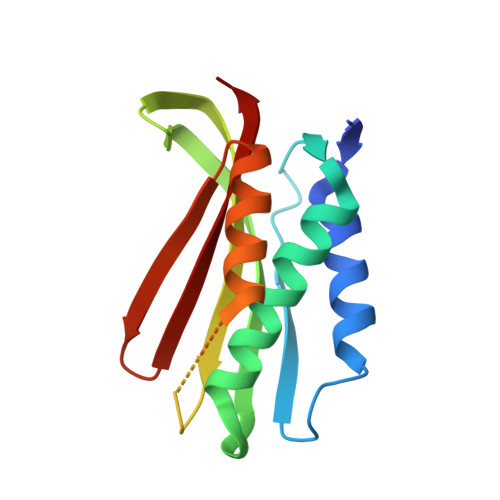Crystal Structure of the C-terminal Domain of the Two-Component System Transmitter Protein Nitrogen Regulator II (NRII; NtrB), Regulator of Nitrogen Assimilation in Escherichia coli.
Song, Y., Peisach, D., Pioszak, A.A., Xu, Z., Ninfa, A.J.(2004) Biochemistry 43: 6670-6678
- PubMed: 15157101
- DOI: https://doi.org/10.1021/bi049474r
- Primary Citation of Related Structures:
1R62 - PubMed Abstract:
The kinase/phosphatase nitrogen regulator II (NRII, NtrB) is a member of the transmitter protein family of conserved two-component signal transduction systems. The kinase activity of NRII brings about the phosphorylation of the transcription factor nitrogen regulator I (NRI, NtrC), causing the activation of Ntr gene transcription. The phosphatase activity of NRII results in the inactivation of NRI-P. The activities of NRII are regulated by the signal transduction protein encoded by glnB, PII protein, which upon binding to NRII inhibits the kinase and activates the phosphatase activity. The C-terminal ATP-binding domain of NRII is required for both the kinase and phosphatase activities and contains the PII binding site. Here, we present the crystal structure of the C-terminal domain of a mutant form of NRII, NRII-Y302N, at 1.6 A resolution and compare this structure to the analogous domains of other two-component system transmitter proteins. While the C-terminal domain of NRII shares the general tertiary structure seen in CheA, PhoQ, and EnvZ transmitter proteins, it contains a distinct beta-hairpin projection that is absent in these related proteins. This projection is near the site of a well-characterized mutation that reduces the binding of PII and near other less-characterized mutations that affect the phosphatase activity of NRII. Sequence alignment suggests that the beta-hairpin projection is present in NRII proteins from various organisms, and absent in other transmitter proteins from Escherichia coliK-12. This unique structural element in the NRII C-terminal domain may play a role in binding PII or in intramolecular signal transduction.
Organizational Affiliation:
Department of Biological Chemistry, University of Michigan Medical School, Ann Arbor, Michigan 48109-0606, USA.














